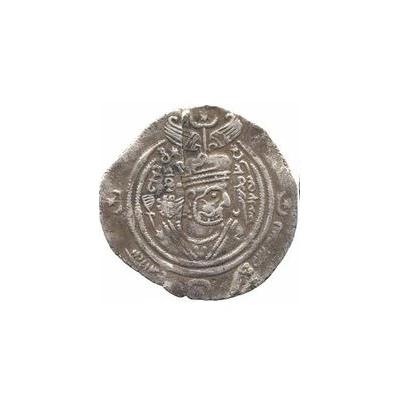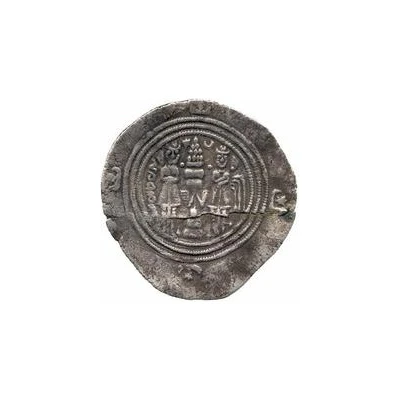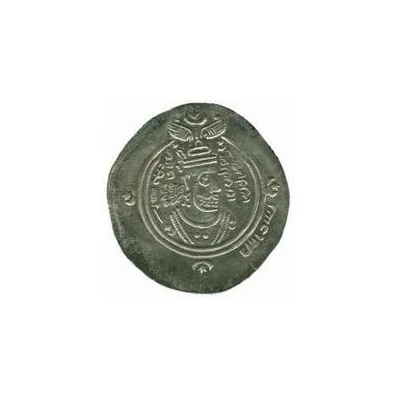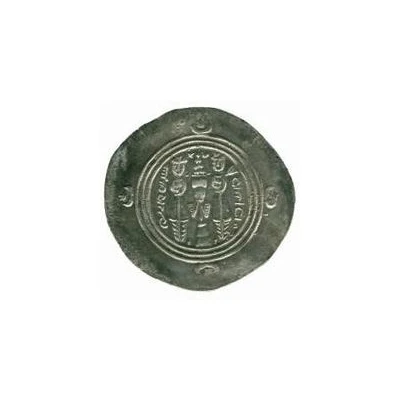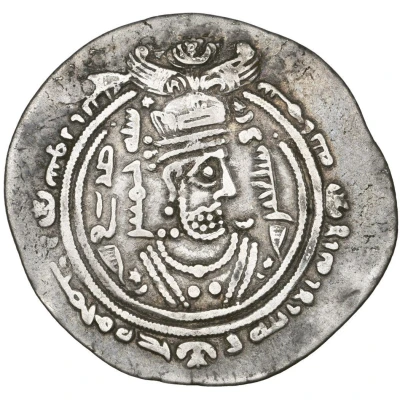
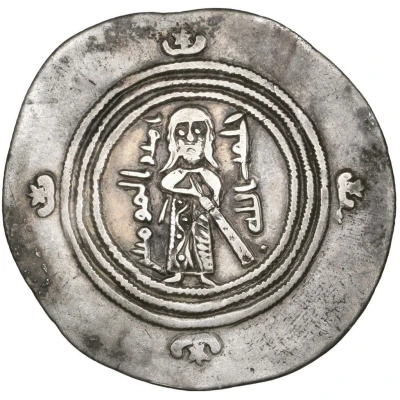

Drachm - Abd Al-Malik b. Marwan
75 (694) year| Silver | 3.53 g | - |
| Issuer | Umayyad Caliphate |
|---|---|
| Type | Non-circulating coin |
| Year | 75 (694) |
| Calendar | Islamic (Hijri) |
| Value | Drachm (1) |
| Currency | Drachm (661-750) |
| Composition | Silver |
| Weight | 3.53 g |
| Shape | Round (irregular) |
| Technique | Hammered |
| Demonetized | Yes |
| Updated | 2024-10-05 |
| Numista | N#418986 |
|---|---|
| Rarity index | 100% |
Reverse
Standing figure of caliph facing, wearing elaborate robe and with right hand on sheathed sword; To left: amir al-mu’minin; to right: khalifat Allah.
Script: Arabic (kufic)
Lettering: امیرالمومنین خلفت الله
Comment
When the caliph ‘Abd al-Malik b. Marwan decided to issue both gold and silver coins there in the early 70s, his gold coinage was based on Byzantine solidi: an obvious choice since Damascus had been part of the Byzantine empire and such coins were familiar there. For his new silver coins, however, ‘Abd al-Malik looked to Sasanian silver drachms for a prototype. This was also a natural decision given that they had been the dominant silver coin in the East for centuries, and the Muslims had continued to strike Arab-Sasanian drachms at dozens of mints for more than forty years. Between 72-74h ‘Abd al-Malik struck several varieties of drachms at Damascus, all close imitations of the Sasanian originals. His first coins appear to have had purely Arabic legends, and it may reflect a fundamental flaw in the design that his later drachms bear the name of the long-dead Sasanian Khusraw II written in Pahlawi - a language with no relevance to Syria nor to the Arabs striking the coins. In 74h ‘Abd al-Malik began to strike new gold dinars and copper fulus at Damascus, all of which bore a standing figure of the Caliph on the obverse and a modified cross-on-steps on the reverse. It is generally accepted that Standing Caliph dirhams such as the present coin were also produced at Damascus to accompany these new gold and copper issues, although unlike the earlier drachms they lack a mint-name and production seems to have begun in the following year. Their design exemplifies the mixture of Byzantine, Sasanian and Islamic influences on the new Damascus silver coinage. On the obverse is the bust of the Sasanian king Khusraw II, shorn of all remaining Pahlawi inscriptions and accompanied only by Islamic religious legends and the year of striking, all rendered in Arabic. On the reverse is the figure of the Caliph himself, flanked by Arabic legends stating unequivocally that he is the ‘Commander of the Faithful’ and ‘Caliph of God’. The relationship between the iconography of the Umayyad caliph and contemporary depictions of the Byzantine emperor are clearly expressed by Miles: ‘It is, I believe, self-evident…that the standing figure on the Arab coins was designed with the thought of producing a rival…of the representation of the emperor…a figure of the same general appearance, but specifically Arab and Muslim as opposed to Byzantine and Christian. The emperor wears a crown; the caliph wears the kufiya. The emperor holds a cross; the caliph carries a sword and is prepared to draw it against the enemies of Islam.’ (Miles 1967, p.216). While the standing figure of the Caliph is a striking expression of the power of Islam, its position on the reverse, rather than the obverse as on the gold and silver Standing Caliph coins, may quickly have been seen as problematic. Treadwell notes that the gold and copper coins conformed to ‘the traditional numismatic formula that located the ruler on the obverse and a religious symbol on the reverse,’ while the ‘Standing Caliph’ drachm ‘contained two conflicting images of rulership…it is the Shahanshah’s imposing bust that dominates the imagery of the coin.
Interesting fact
The Umayyad Caliphate, which issued the Drachm - Abd Al-Malik b. Marwan 75 (694) coin, was the first Islamic caliphate, and it played a significant role in the spread of Islam throughout the Middle East, North Africa, and parts of Europe. The caliphate was established by Muawiyah ibn Abu Sufyan, a companion of the Prophet Muhammad, in 661 CE, and it lasted for over a century until its overthrow in 750 CE. During its reign, the Umayyad Caliphate was known for its military conquests, administrative reforms, and cultural achievements, including the development of Arabic as a written language and the construction of the Dome of the Rock in Jerusalem.
